Effective Business Communication Analysis and Action Plan Report
VerifiedAdded on 2020/03/28
|23
|3749
|25
Report
AI Summary
This report undertakes a comprehensive analysis of effective business communication, employing five diagnostic tools including the Johari Window and assertive communication tests to assess the author's communication style within a professional context. The findings reveal key communication issues, specifically a deficiency in active listening skills and a lack of confidence in face-to-face interactions, supported by real-world examples. A detailed literature review explores these issues, examining theoretical perspectives and communication models. Finally, the report culminates in a practical action plan, outlining strategies such as short courses, postgraduate studies, a reading plan, journaling, and mentorship to address the identified weaknesses and foster improved communication skills for enhanced professional performance.
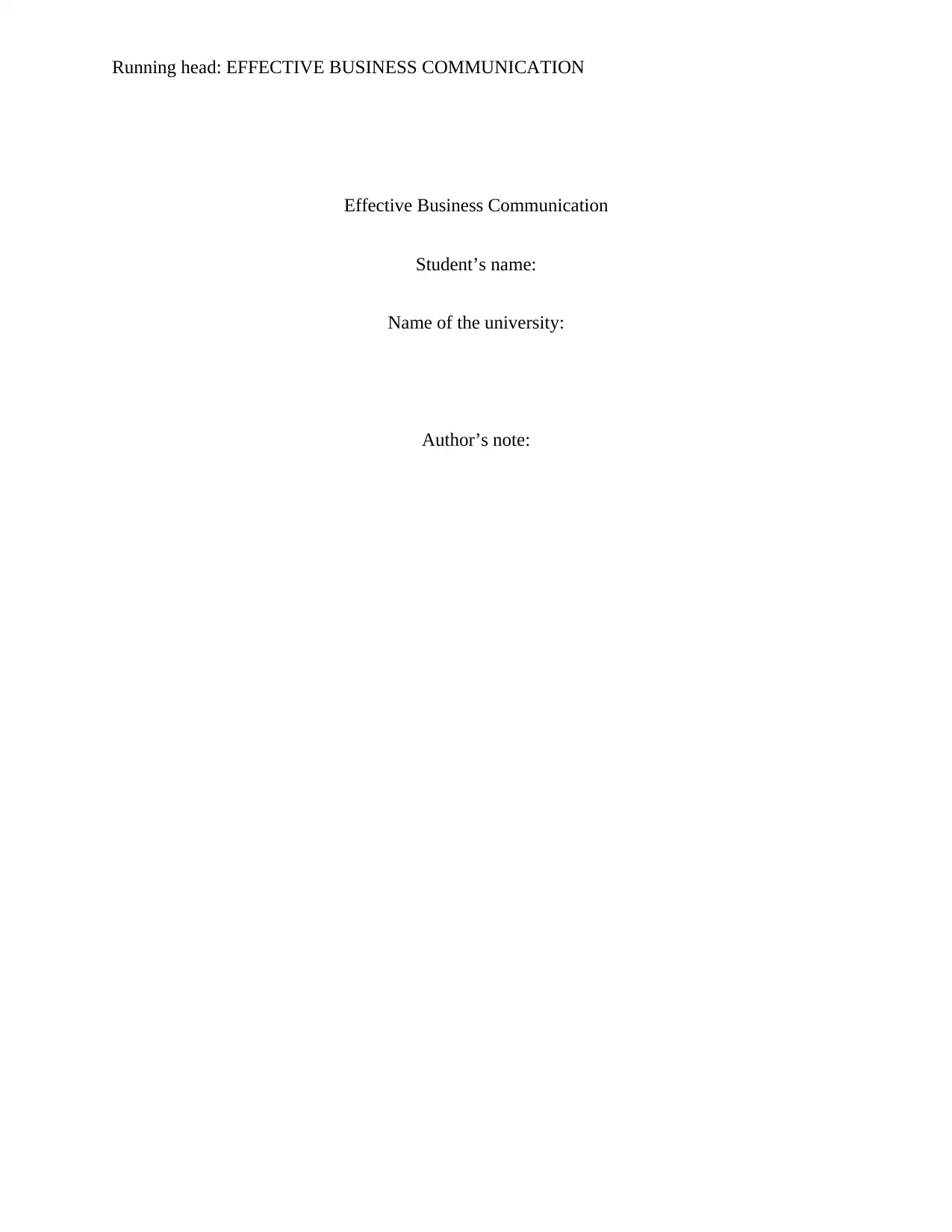
Running head: EFFECTIVE BUSINESS COMMUNICATION
Effective Business Communication
Student’s name:
Name of the university:
Author’s note:
Effective Business Communication
Student’s name:
Name of the university:
Author’s note:
Paraphrase This Document
Need a fresh take? Get an instant paraphrase of this document with our AI Paraphraser
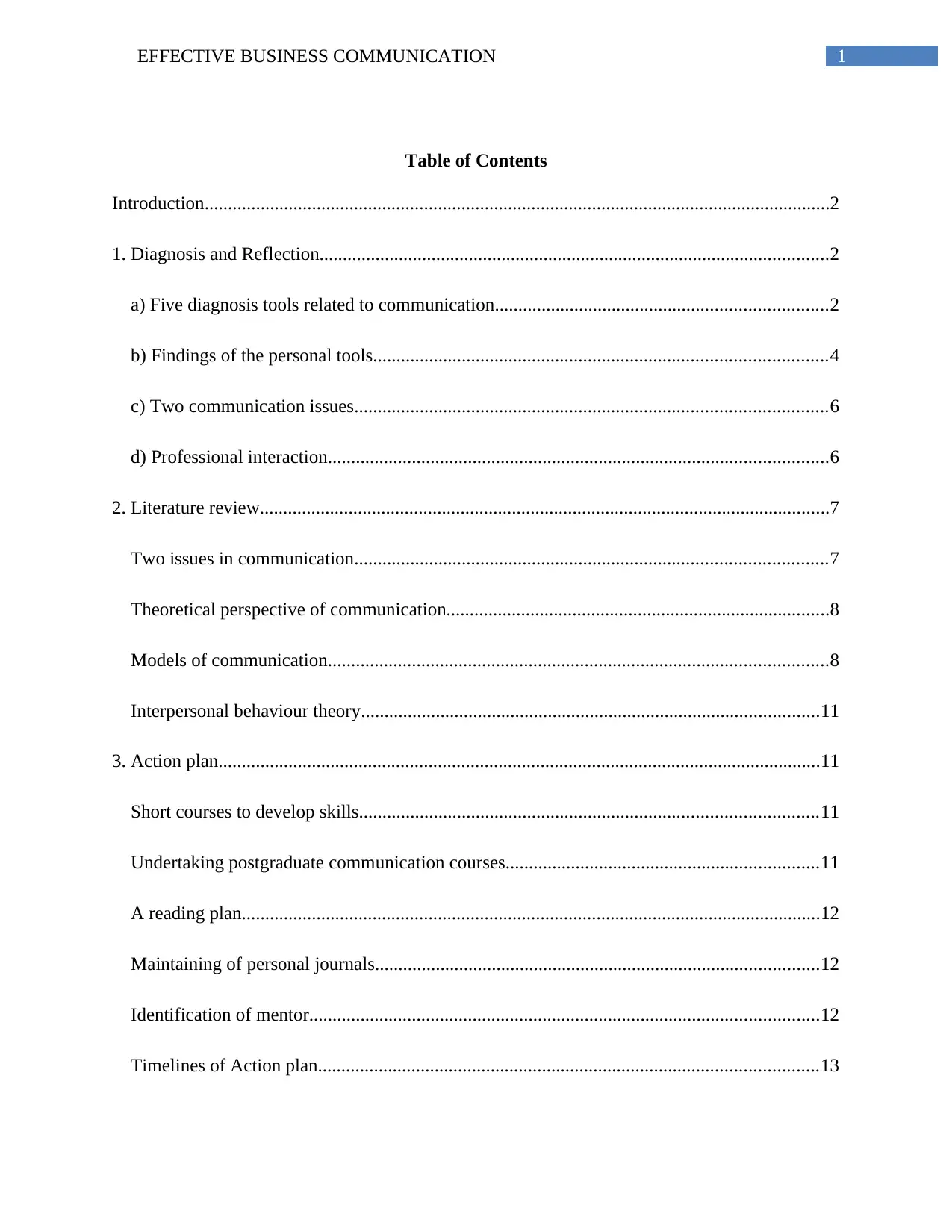
1EFFECTIVE BUSINESS COMMUNICATION
Table of Contents
Introduction......................................................................................................................................2
1. Diagnosis and Reflection.............................................................................................................2
a) Five diagnosis tools related to communication.......................................................................2
b) Findings of the personal tools.................................................................................................4
c) Two communication issues.....................................................................................................6
d) Professional interaction...........................................................................................................6
2. Literature review..........................................................................................................................7
Two issues in communication.....................................................................................................7
Theoretical perspective of communication..................................................................................8
Models of communication...........................................................................................................8
Interpersonal behaviour theory..................................................................................................11
3. Action plan.................................................................................................................................11
Short courses to develop skills..................................................................................................11
Undertaking postgraduate communication courses...................................................................11
A reading plan............................................................................................................................12
Maintaining of personal journals...............................................................................................12
Identification of mentor.............................................................................................................12
Timelines of Action plan...........................................................................................................13
Table of Contents
Introduction......................................................................................................................................2
1. Diagnosis and Reflection.............................................................................................................2
a) Five diagnosis tools related to communication.......................................................................2
b) Findings of the personal tools.................................................................................................4
c) Two communication issues.....................................................................................................6
d) Professional interaction...........................................................................................................6
2. Literature review..........................................................................................................................7
Two issues in communication.....................................................................................................7
Theoretical perspective of communication..................................................................................8
Models of communication...........................................................................................................8
Interpersonal behaviour theory..................................................................................................11
3. Action plan.................................................................................................................................11
Short courses to develop skills..................................................................................................11
Undertaking postgraduate communication courses...................................................................11
A reading plan............................................................................................................................12
Maintaining of personal journals...............................................................................................12
Identification of mentor.............................................................................................................12
Timelines of Action plan...........................................................................................................13
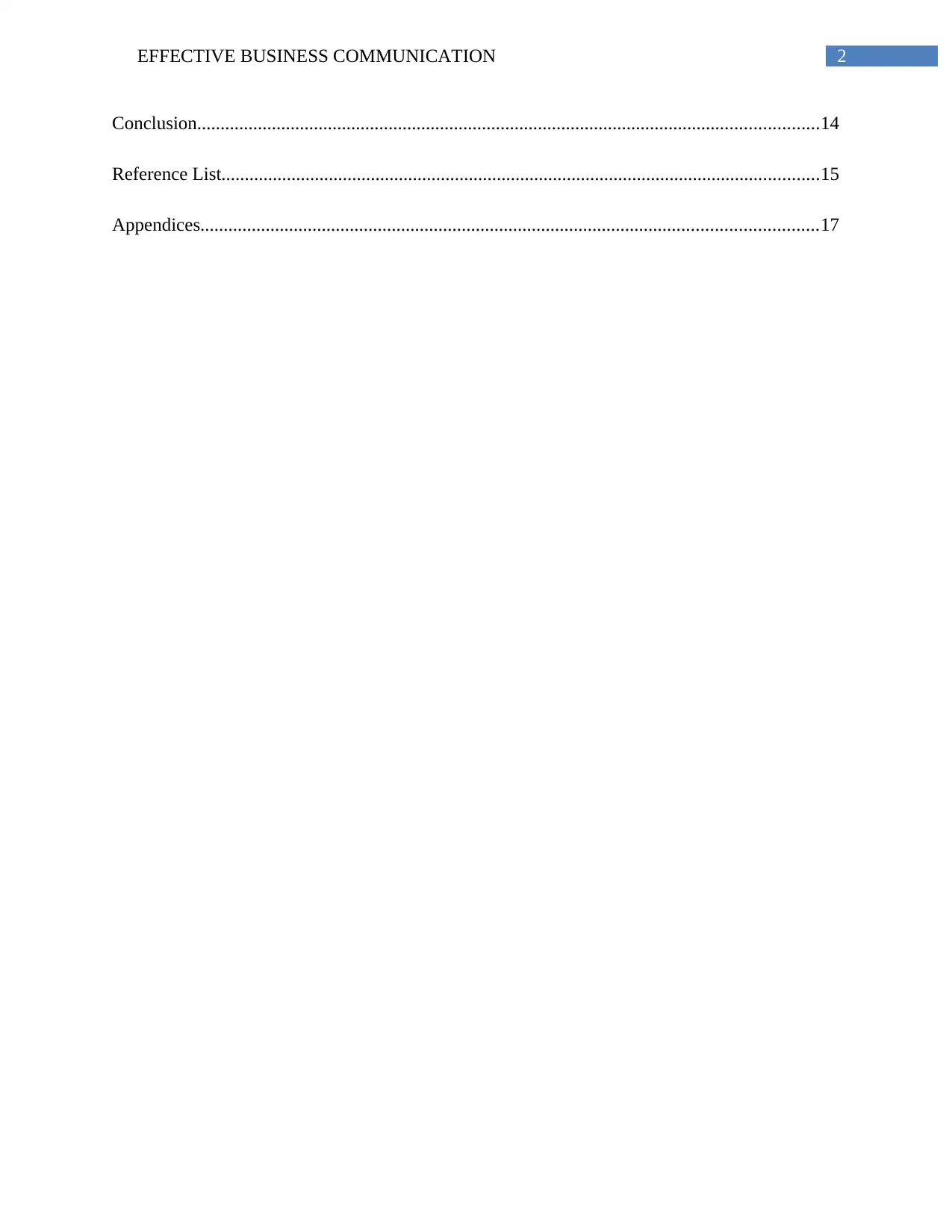
2EFFECTIVE BUSINESS COMMUNICATION
Conclusion.....................................................................................................................................14
Reference List................................................................................................................................15
Appendices....................................................................................................................................17
Conclusion.....................................................................................................................................14
Reference List................................................................................................................................15
Appendices....................................................................................................................................17
⊘ This is a preview!⊘
Do you want full access?
Subscribe today to unlock all pages.

Trusted by 1+ million students worldwide

3EFFECTIVE BUSINESS COMMUNICATION
s
Introduction
The main aim of the study is to analyse my communication style in the workplace using
five communication diagnostic tools. This study will help me in identifying personal capability
and issues. In the first section, five diagnostic tools have been described and analysed as per my
point of view. From those tests, I would identify my two communication issues. In the next
section, a literature review on communication and its issues will be described. In the last section,
an action plan will be given based on my development of communication issues.
1. Diagnosis and Reflection
a) Five diagnosis tools related to communication
Workplace communication is significant as it gives the organisations to have productivity
and run effectively. Employees have to communicate in right manner that must increase in
morale. In this study five communication diagnostic tools are going to use, these five are Johari
Window, Assertive communication test, communication style questionnaire, psychological
interactive communication and interpersonal communication test.
Johari window
Johari window communication tools help people to understand themselves and others.
This communication tool was used by self-help group as heuristic exercise. This model has
mainly four quadrants and people are asked to pick five or six adjectives from given list. From
these adjectives which better describes the personality of the users, they can choose them. The
first quadrant is about Arena (open) and this is related to the characteristics that perceive the
s
Introduction
The main aim of the study is to analyse my communication style in the workplace using
five communication diagnostic tools. This study will help me in identifying personal capability
and issues. In the first section, five diagnostic tools have been described and analysed as per my
point of view. From those tests, I would identify my two communication issues. In the next
section, a literature review on communication and its issues will be described. In the last section,
an action plan will be given based on my development of communication issues.
1. Diagnosis and Reflection
a) Five diagnosis tools related to communication
Workplace communication is significant as it gives the organisations to have productivity
and run effectively. Employees have to communicate in right manner that must increase in
morale. In this study five communication diagnostic tools are going to use, these five are Johari
Window, Assertive communication test, communication style questionnaire, psychological
interactive communication and interpersonal communication test.
Johari window
Johari window communication tools help people to understand themselves and others.
This communication tool was used by self-help group as heuristic exercise. This model has
mainly four quadrants and people are asked to pick five or six adjectives from given list. From
these adjectives which better describes the personality of the users, they can choose them. The
first quadrant is about Arena (open) and this is related to the characteristics that perceive the
Paraphrase This Document
Need a fresh take? Get an instant paraphrase of this document with our AI Paraphraser
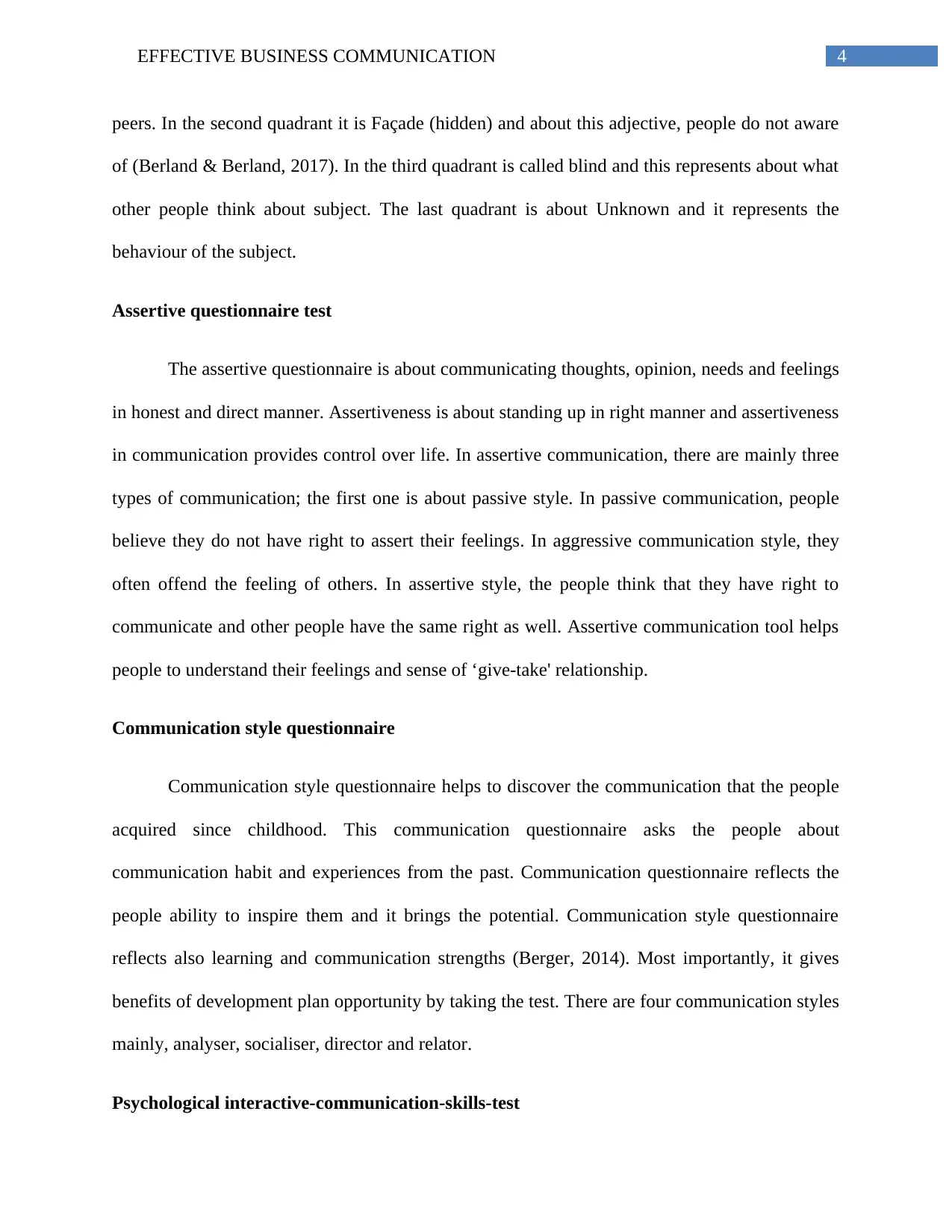
4EFFECTIVE BUSINESS COMMUNICATION
peers. In the second quadrant it is Façade (hidden) and about this adjective, people do not aware
of (Berland & Berland, 2017). In the third quadrant is called blind and this represents about what
other people think about subject. The last quadrant is about Unknown and it represents the
behaviour of the subject.
Assertive questionnaire test
The assertive questionnaire is about communicating thoughts, opinion, needs and feelings
in honest and direct manner. Assertiveness is about standing up in right manner and assertiveness
in communication provides control over life. In assertive communication, there are mainly three
types of communication; the first one is about passive style. In passive communication, people
believe they do not have right to assert their feelings. In aggressive communication style, they
often offend the feeling of others. In assertive style, the people think that they have right to
communicate and other people have the same right as well. Assertive communication tool helps
people to understand their feelings and sense of ‘give-take' relationship.
Communication style questionnaire
Communication style questionnaire helps to discover the communication that the people
acquired since childhood. This communication questionnaire asks the people about
communication habit and experiences from the past. Communication questionnaire reflects the
people ability to inspire them and it brings the potential. Communication style questionnaire
reflects also learning and communication strengths (Berger, 2014). Most importantly, it gives
benefits of development plan opportunity by taking the test. There are four communication styles
mainly, analyser, socialiser, director and relator.
Psychological interactive-communication-skills-test
peers. In the second quadrant it is Façade (hidden) and about this adjective, people do not aware
of (Berland & Berland, 2017). In the third quadrant is called blind and this represents about what
other people think about subject. The last quadrant is about Unknown and it represents the
behaviour of the subject.
Assertive questionnaire test
The assertive questionnaire is about communicating thoughts, opinion, needs and feelings
in honest and direct manner. Assertiveness is about standing up in right manner and assertiveness
in communication provides control over life. In assertive communication, there are mainly three
types of communication; the first one is about passive style. In passive communication, people
believe they do not have right to assert their feelings. In aggressive communication style, they
often offend the feeling of others. In assertive style, the people think that they have right to
communicate and other people have the same right as well. Assertive communication tool helps
people to understand their feelings and sense of ‘give-take' relationship.
Communication style questionnaire
Communication style questionnaire helps to discover the communication that the people
acquired since childhood. This communication questionnaire asks the people about
communication habit and experiences from the past. Communication questionnaire reflects the
people ability to inspire them and it brings the potential. Communication style questionnaire
reflects also learning and communication strengths (Berger, 2014). Most importantly, it gives
benefits of development plan opportunity by taking the test. There are four communication styles
mainly, analyser, socialiser, director and relator.
Psychological interactive-communication-skills-test

5EFFECTIVE BUSINESS COMMUNICATION
Interactive communication skill test gives the benefits of learning the communication in
various processes, like listening, speaking and writing and even in reading. In order to be expert
communicator the communication skill test teaches the two points, sender and receiver.
Communications channels are various, face-to-face, written, voice and body language as well.
Interpersonal-communication-skills tests:
Interpersonal communication helps in the workplace in each stage and it needs in
negotiating, resolving, in the discussion of promotion and communicating with hierarchy.
Interpersonal communication test asks a few questions about the user and it includes social
interaction, workplace communication and reflective type's questions (Fussell & Kreuz, 2014).
Then, based upon answers of the people, it analyses the people’s choices in insightful, verbal
expression, assertiveness, listening skills and emotion management.
b) Findings of the personal tools
Findings from Johari window: Johari window test tells me about my Facade side that is
known to me but other people do not know these facts. My Façade quadrant is comprised with
cheerful, friendly, happy, intelligent, and mature and introvert. In Unknown quadrant, I do not
know about myself that I am accepting, adaptable, modest and nervous and much more. People
or employees who work with me are unaware of the Façade side and they might be untrue also.
Moreover, in the Unknown quadrant and these, all adjectives represent my behaviour that no one
may recognise. These factors are my collective ignorance of the traits.
Findings from the assertive questionnaire: This questionnaire test describes the style
of communication and it represents that I seldom hesitate to address my issue to the other people.
In this scenario, I am not introvert to hide my feelings and concerns. I try to bring the issue to
Interactive communication skill test gives the benefits of learning the communication in
various processes, like listening, speaking and writing and even in reading. In order to be expert
communicator the communication skill test teaches the two points, sender and receiver.
Communications channels are various, face-to-face, written, voice and body language as well.
Interpersonal-communication-skills tests:
Interpersonal communication helps in the workplace in each stage and it needs in
negotiating, resolving, in the discussion of promotion and communicating with hierarchy.
Interpersonal communication test asks a few questions about the user and it includes social
interaction, workplace communication and reflective type's questions (Fussell & Kreuz, 2014).
Then, based upon answers of the people, it analyses the people’s choices in insightful, verbal
expression, assertiveness, listening skills and emotion management.
b) Findings of the personal tools
Findings from Johari window: Johari window test tells me about my Facade side that is
known to me but other people do not know these facts. My Façade quadrant is comprised with
cheerful, friendly, happy, intelligent, and mature and introvert. In Unknown quadrant, I do not
know about myself that I am accepting, adaptable, modest and nervous and much more. People
or employees who work with me are unaware of the Façade side and they might be untrue also.
Moreover, in the Unknown quadrant and these, all adjectives represent my behaviour that no one
may recognise. These factors are my collective ignorance of the traits.
Findings from the assertive questionnaire: This questionnaire test describes the style
of communication and it represents that I seldom hesitate to address my issue to the other people.
In this scenario, I am not introvert to hide my feelings and concerns. I try to bring the issue to
⊘ This is a preview!⊘
Do you want full access?
Subscribe today to unlock all pages.

Trusted by 1+ million students worldwide
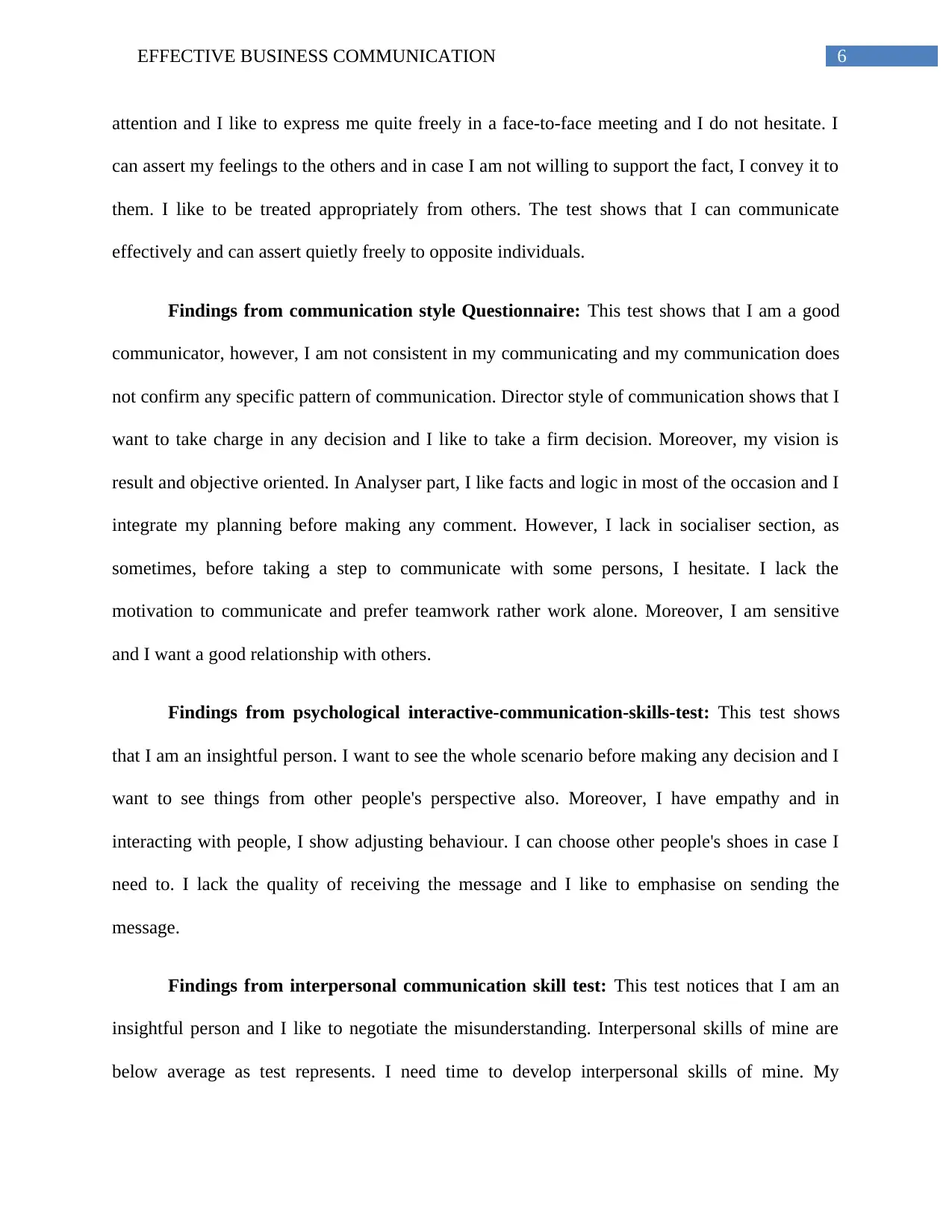
6EFFECTIVE BUSINESS COMMUNICATION
attention and I like to express me quite freely in a face-to-face meeting and I do not hesitate. I
can assert my feelings to the others and in case I am not willing to support the fact, I convey it to
them. I like to be treated appropriately from others. The test shows that I can communicate
effectively and can assert quietly freely to opposite individuals.
Findings from communication style Questionnaire: This test shows that I am a good
communicator, however, I am not consistent in my communicating and my communication does
not confirm any specific pattern of communication. Director style of communication shows that I
want to take charge in any decision and I like to take a firm decision. Moreover, my vision is
result and objective oriented. In Analyser part, I like facts and logic in most of the occasion and I
integrate my planning before making any comment. However, I lack in socialiser section, as
sometimes, before taking a step to communicate with some persons, I hesitate. I lack the
motivation to communicate and prefer teamwork rather work alone. Moreover, I am sensitive
and I want a good relationship with others.
Findings from psychological interactive-communication-skills-test: This test shows
that I am an insightful person. I want to see the whole scenario before making any decision and I
want to see things from other people's perspective also. Moreover, I have empathy and in
interacting with people, I show adjusting behaviour. I can choose other people's shoes in case I
need to. I lack the quality of receiving the message and I like to emphasise on sending the
message.
Findings from interpersonal communication skill test: This test notices that I am an
insightful person and I like to negotiate the misunderstanding. Interpersonal skills of mine are
below average as test represents. I need time to develop interpersonal skills of mine. My
attention and I like to express me quite freely in a face-to-face meeting and I do not hesitate. I
can assert my feelings to the others and in case I am not willing to support the fact, I convey it to
them. I like to be treated appropriately from others. The test shows that I can communicate
effectively and can assert quietly freely to opposite individuals.
Findings from communication style Questionnaire: This test shows that I am a good
communicator, however, I am not consistent in my communicating and my communication does
not confirm any specific pattern of communication. Director style of communication shows that I
want to take charge in any decision and I like to take a firm decision. Moreover, my vision is
result and objective oriented. In Analyser part, I like facts and logic in most of the occasion and I
integrate my planning before making any comment. However, I lack in socialiser section, as
sometimes, before taking a step to communicate with some persons, I hesitate. I lack the
motivation to communicate and prefer teamwork rather work alone. Moreover, I am sensitive
and I want a good relationship with others.
Findings from psychological interactive-communication-skills-test: This test shows
that I am an insightful person. I want to see the whole scenario before making any decision and I
want to see things from other people's perspective also. Moreover, I have empathy and in
interacting with people, I show adjusting behaviour. I can choose other people's shoes in case I
need to. I lack the quality of receiving the message and I like to emphasise on sending the
message.
Findings from interpersonal communication skill test: This test notices that I am an
insightful person and I like to negotiate the misunderstanding. Interpersonal skills of mine are
below average as test represents. I need time to develop interpersonal skills of mine. My
Paraphrase This Document
Need a fresh take? Get an instant paraphrase of this document with our AI Paraphraser

7EFFECTIVE BUSINESS COMMUNICATION
listening skill is above average and I lack active listening skills. My emotional intelligence is
below average and it is related to the understanding and dealing with emotions. My verbal
communication in face-to-face is below average and it may come from lack of self-esteem and
confidence. However, in communicating in the group, I scored well and it shows that in a group
situation, I can handle the matter effectively.
c) Two communication issues
I have two communication issues that I understood undertaking the tests. First one is
active listening skill and second is lack of confidence in face-to-face communication. Active
listening is the process of conscious decision that is made from understanding the message of the
opposite speaker (Knapp, Vangelisti & Caughlin, 2014). Listening is one of the fundamental
components of interpersonal communication in the workplace. In the second case, confidence is
faith and trusts that makeable one person to make active conversation. Realistic feeling and
expectation about confidence can make successful in communication.
d) Professional interaction
Last month, in my workplace, I had to handle two clients over the phone. During that time, I
faced the issue of active listening skills. Client handling is not an easy matter and I have the issue
of active listening. Selective listening is kind of game plan about how one is controlling the
conversation (Hybels, 2014). I possibly spoke more and listen less. In case of active listening, I
have certain tendencies to presume certain things and keep blank for sometimes. I have some
prejudices and I did not call the clients from myself and I waited when they called me.
In another scenario, I had to attend an interview for my internship in an organisation. I felt
tremendous pressure during the face-to-face interview session and I lacked confidence in myself.
listening skill is above average and I lack active listening skills. My emotional intelligence is
below average and it is related to the understanding and dealing with emotions. My verbal
communication in face-to-face is below average and it may come from lack of self-esteem and
confidence. However, in communicating in the group, I scored well and it shows that in a group
situation, I can handle the matter effectively.
c) Two communication issues
I have two communication issues that I understood undertaking the tests. First one is
active listening skill and second is lack of confidence in face-to-face communication. Active
listening is the process of conscious decision that is made from understanding the message of the
opposite speaker (Knapp, Vangelisti & Caughlin, 2014). Listening is one of the fundamental
components of interpersonal communication in the workplace. In the second case, confidence is
faith and trusts that makeable one person to make active conversation. Realistic feeling and
expectation about confidence can make successful in communication.
d) Professional interaction
Last month, in my workplace, I had to handle two clients over the phone. During that time, I
faced the issue of active listening skills. Client handling is not an easy matter and I have the issue
of active listening. Selective listening is kind of game plan about how one is controlling the
conversation (Hybels, 2014). I possibly spoke more and listen less. In case of active listening, I
have certain tendencies to presume certain things and keep blank for sometimes. I have some
prejudices and I did not call the clients from myself and I waited when they called me.
In another scenario, I had to attend an interview for my internship in an organisation. I felt
tremendous pressure during the face-to-face interview session and I lacked confidence in myself.

8EFFECTIVE BUSINESS COMMUNICATION
I am a bit shy and I lack the assertiveness. My self-worth possibly hinders the communication. I
fumbled for sometimes and my reaction was not good.
2. Literature review
Two issues in communication
Active listening skills
Listening is very significant in effective communication as without active listening
messages would be misunderstood. In the absence of active listening, communication breaks
down and sender of the messages get frustrated (Thather & Evia, 2017). In employability skills,
the employers want that employees must have active listening skills. Some people think that
listening is not as same as hearing as listening needs attention and concentration effort. Language
is important in active listening as listener needs to understand what the sender says. Listening
process is related to the verbal as well as non-verbal messages. Listening skills can be developed
by being attentive and relaxed. The individual needs to keep an open mind and listen to the world
carefully. The individual can make a picture of words of the sender and individuals should not
disturb the speakers.
Confidence issue in face-to-face communication
Confidence comes from within and from trust or faith within oneself. Realistic confidence on
oneself can create positive self-esteem. In communicating in the workplace, the employees need
to possess self-confidence as it allows one person to be free from fear and anxiety. It does mean
that the people would become reckless and overconfident in making any decision. Extrovert
people have confidence in doing any work and reasonable expectation brings out best at the
I am a bit shy and I lack the assertiveness. My self-worth possibly hinders the communication. I
fumbled for sometimes and my reaction was not good.
2. Literature review
Two issues in communication
Active listening skills
Listening is very significant in effective communication as without active listening
messages would be misunderstood. In the absence of active listening, communication breaks
down and sender of the messages get frustrated (Thather & Evia, 2017). In employability skills,
the employers want that employees must have active listening skills. Some people think that
listening is not as same as hearing as listening needs attention and concentration effort. Language
is important in active listening as listener needs to understand what the sender says. Listening
process is related to the verbal as well as non-verbal messages. Listening skills can be developed
by being attentive and relaxed. The individual needs to keep an open mind and listen to the world
carefully. The individual can make a picture of words of the sender and individuals should not
disturb the speakers.
Confidence issue in face-to-face communication
Confidence comes from within and from trust or faith within oneself. Realistic confidence on
oneself can create positive self-esteem. In communicating in the workplace, the employees need
to possess self-confidence as it allows one person to be free from fear and anxiety. It does mean
that the people would become reckless and overconfident in making any decision. Extrovert
people have confidence in doing any work and reasonable expectation brings out best at the
⊘ This is a preview!⊘
Do you want full access?
Subscribe today to unlock all pages.

Trusted by 1+ million students worldwide
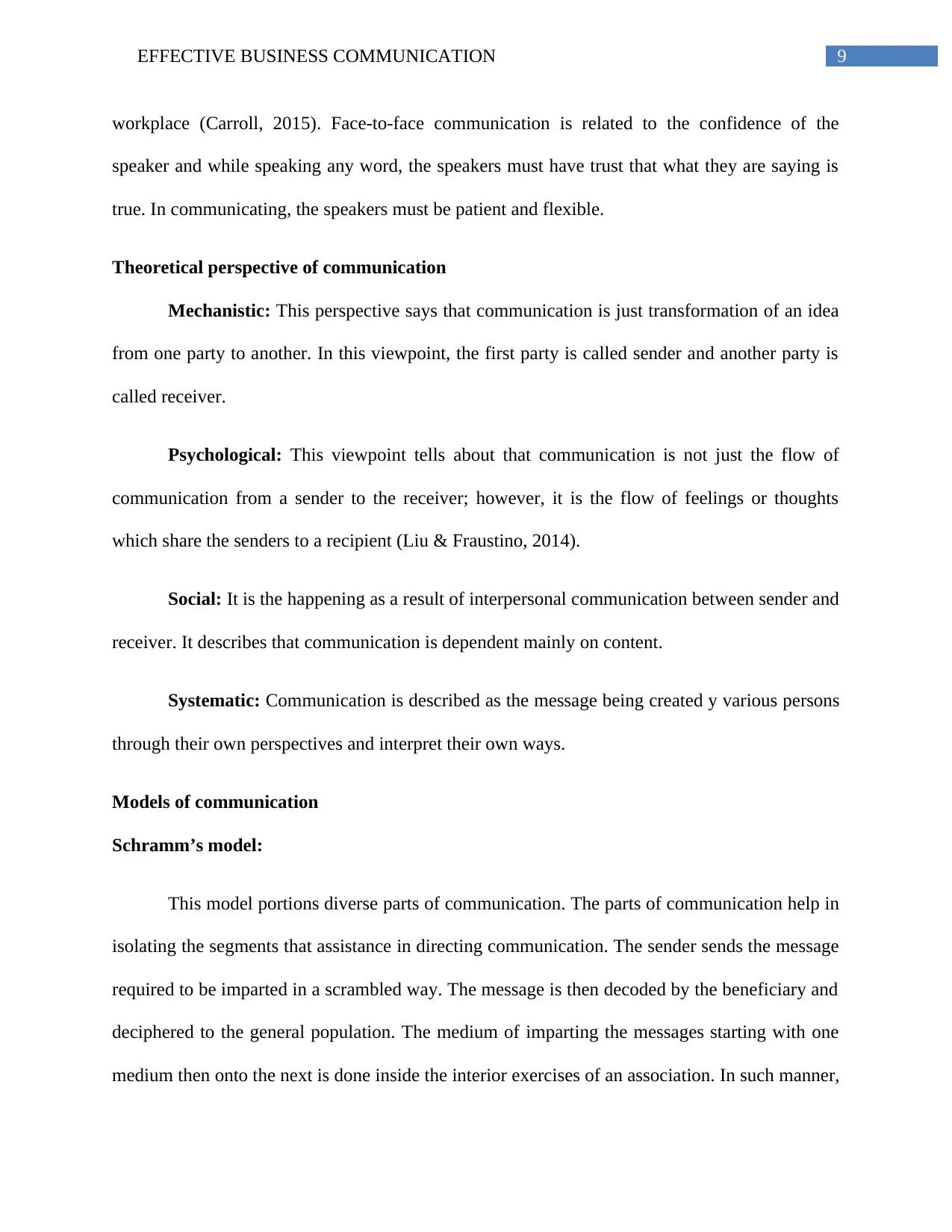
9EFFECTIVE BUSINESS COMMUNICATION
workplace (Carroll, 2015). Face-to-face communication is related to the confidence of the
speaker and while speaking any word, the speakers must have trust that what they are saying is
true. In communicating, the speakers must be patient and flexible.
Theoretical perspective of communication
Mechanistic: This perspective says that communication is just transformation of an idea
from one party to another. In this viewpoint, the first party is called sender and another party is
called receiver.
Psychological: This viewpoint tells about that communication is not just the flow of
communication from a sender to the receiver; however, it is the flow of feelings or thoughts
which share the senders to a recipient (Liu & Fraustino, 2014).
Social: It is the happening as a result of interpersonal communication between sender and
receiver. It describes that communication is dependent mainly on content.
Systematic: Communication is described as the message being created y various persons
through their own perspectives and interpret their own ways.
Models of communication
Schramm’s model:
This model portions diverse parts of communication. The parts of communication help in
isolating the segments that assistance in directing communication. The sender sends the message
required to be imparted in a scrambled way. The message is then decoded by the beneficiary and
deciphered to the general population. The medium of imparting the messages starting with one
medium then onto the next is done inside the interior exercises of an association. In such manner,
workplace (Carroll, 2015). Face-to-face communication is related to the confidence of the
speaker and while speaking any word, the speakers must have trust that what they are saying is
true. In communicating, the speakers must be patient and flexible.
Theoretical perspective of communication
Mechanistic: This perspective says that communication is just transformation of an idea
from one party to another. In this viewpoint, the first party is called sender and another party is
called receiver.
Psychological: This viewpoint tells about that communication is not just the flow of
communication from a sender to the receiver; however, it is the flow of feelings or thoughts
which share the senders to a recipient (Liu & Fraustino, 2014).
Social: It is the happening as a result of interpersonal communication between sender and
receiver. It describes that communication is dependent mainly on content.
Systematic: Communication is described as the message being created y various persons
through their own perspectives and interpret their own ways.
Models of communication
Schramm’s model:
This model portions diverse parts of communication. The parts of communication help in
isolating the segments that assistance in directing communication. The sender sends the message
required to be imparted in a scrambled way. The message is then decoded by the beneficiary and
deciphered to the general population. The medium of imparting the messages starting with one
medium then onto the next is done inside the interior exercises of an association. In such manner,
Paraphrase This Document
Need a fresh take? Get an instant paraphrase of this document with our AI Paraphraser

10EFFECTIVE BUSINESS COMMUNICATION
one might say that this model can be compelling for people confronting issues in speaking with
other individuals. As stated by Jensen (2014), this Schramm’s model considers communication
as an endless procedure that requires constant cooperation between individuals. This can
likewise help in creating listening aptitudes as the messages sent by the sender are as encryption
that may require legitimate listening abilities with a specific end goal to unravel the message.
Figure 1: Schramm’s Model of Communication
(Source: McQuail & Windahl, 2015)
Berlo’s model
Berlo's model expresses that relational abilities are of imperative significance keeping in
mind the end goal to transmit a message from sender to collector. This model is additionally
called SMCR demonstrate in which each required factor for every part is broke down and the
abilities required for playing out the components are expressed. The division of components
one might say that this model can be compelling for people confronting issues in speaking with
other individuals. As stated by Jensen (2014), this Schramm’s model considers communication
as an endless procedure that requires constant cooperation between individuals. This can
likewise help in creating listening aptitudes as the messages sent by the sender are as encryption
that may require legitimate listening abilities with a specific end goal to unravel the message.
Figure 1: Schramm’s Model of Communication
(Source: McQuail & Windahl, 2015)
Berlo’s model
Berlo's model expresses that relational abilities are of imperative significance keeping in
mind the end goal to transmit a message from sender to collector. This model is additionally
called SMCR demonstrate in which each required factor for every part is broke down and the
abilities required for playing out the components are expressed. The division of components
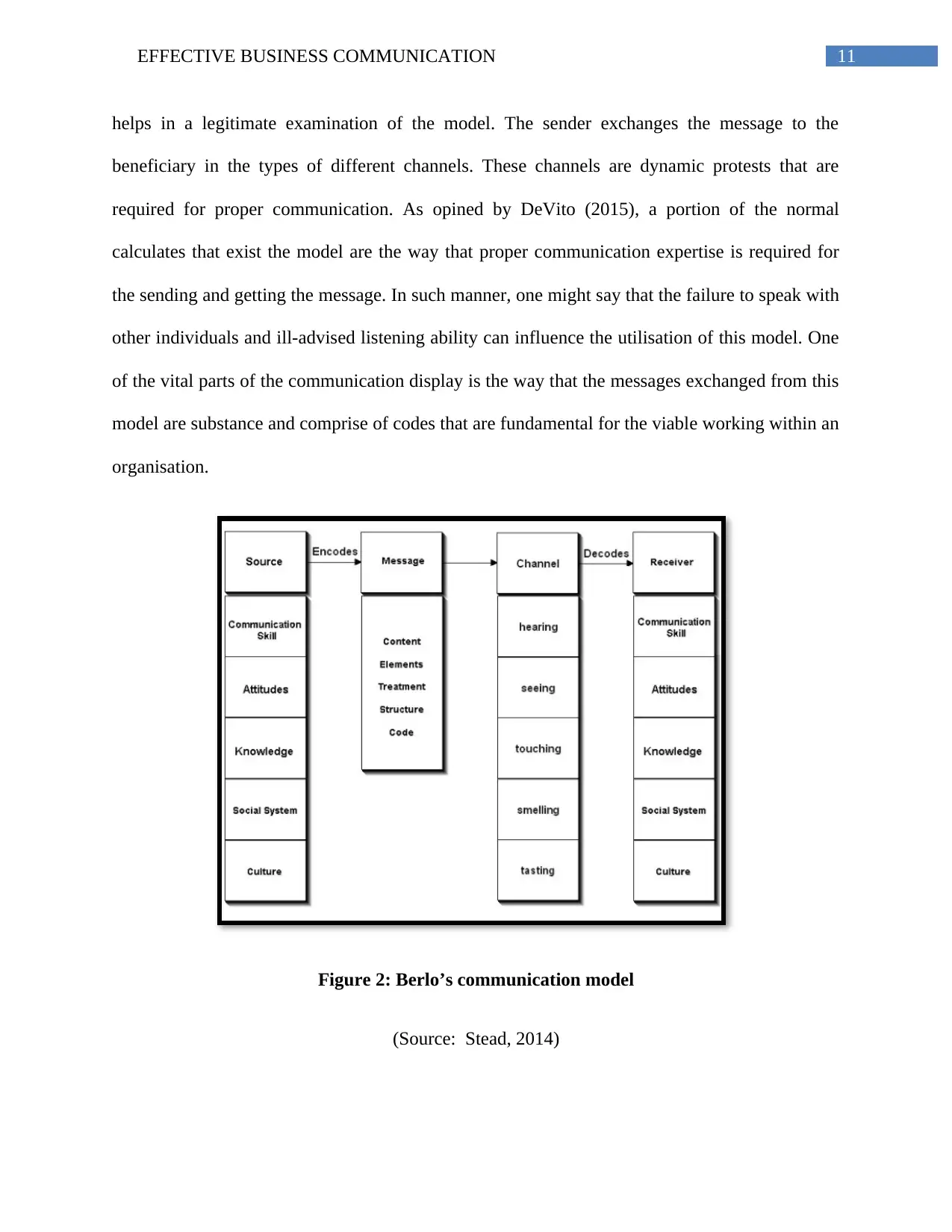
11EFFECTIVE BUSINESS COMMUNICATION
helps in a legitimate examination of the model. The sender exchanges the message to the
beneficiary in the types of different channels. These channels are dynamic protests that are
required for proper communication. As opined by DeVito (2015), a portion of the normal
calculates that exist the model are the way that proper communication expertise is required for
the sending and getting the message. In such manner, one might say that the failure to speak with
other individuals and ill-advised listening ability can influence the utilisation of this model. One
of the vital parts of the communication display is the way that the messages exchanged from this
model are substance and comprise of codes that are fundamental for the viable working within an
organisation.
Figure 2: Berlo’s communication model
(Source: Stead, 2014)
helps in a legitimate examination of the model. The sender exchanges the message to the
beneficiary in the types of different channels. These channels are dynamic protests that are
required for proper communication. As opined by DeVito (2015), a portion of the normal
calculates that exist the model are the way that proper communication expertise is required for
the sending and getting the message. In such manner, one might say that the failure to speak with
other individuals and ill-advised listening ability can influence the utilisation of this model. One
of the vital parts of the communication display is the way that the messages exchanged from this
model are substance and comprise of codes that are fundamental for the viable working within an
organisation.
Figure 2: Berlo’s communication model
(Source: Stead, 2014)
⊘ This is a preview!⊘
Do you want full access?
Subscribe today to unlock all pages.

Trusted by 1+ million students worldwide
1 out of 23
Related Documents
Your All-in-One AI-Powered Toolkit for Academic Success.
+13062052269
info@desklib.com
Available 24*7 on WhatsApp / Email
![[object Object]](/_next/static/media/star-bottom.7253800d.svg)
Unlock your academic potential
Copyright © 2020–2025 A2Z Services. All Rights Reserved. Developed and managed by ZUCOL.





